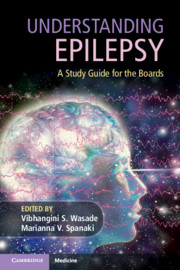Book contents
- Understanding Epilepsy
- Understanding Epilepsy
- Copyright page
- Dedication
- Contents
- Contributors
- Preface
- Chapter 1 Pathophysiology of Epilepsy
- Chapter 2 Physiologic Basis of Epileptic EEG Patterns
- Chapter 3 Pathology of the Epilepsies
- Chapter 4 Classifications of Seizures and Epilepsies
- Chapter 5 Electro-clinical Syndromes and Epilepsies in the Neonatal Period, Infancy, and Childhood
- Chapter 6 Familial Electro-clinical Syndromes and Epilepsies in Adolescence to Adulthood
- Chapter 7 Distinctive Constellations and Other Epilepsies
- Chapter 8 Seizures Not Diagnosed as Epilepsy
- Chapter 9 Nonepileptic Spells
- Chapter 10 Status Epilepticus
- Chapter 11 EEG Instrumentation and Basics
- Chapter 12 Interpreting the Normal Electroencephalogram of an Adult
- Chapter 13 Ictal and Interictal Epileptiform Electroencephalogram Patterns
- Chapter 14 Neonatal and Pediatric Electroencephalogram
- Chapter 15 Scalp Video-EEG Monitoring
- Chapter 16 Intracranial EEG Monitoring
- Chapter 17 Neuroimaging in Epilepsy
- Chapter 18 The Role of Neuropsychology in Epilepsy Surgery
- Chapter 19 Principles of Antiseizure Drug Management
- Chapter 20 Gender Issues in Epilepsy
- Chapter 21 Antiseizure Drugs
- Chapter 22 Surgical Therapies for Epilepsy
- Chapter 23 Stimulation Therapies for Epilepsy
- Chapter 24 Practical and Psychosocial Considerations in Epilepsy Management
- Chapter 25 Comorbidities with Epilepsy
- Chapter 26 System-Based Issues in Epilepsy
- Index
- References
Chapter 21 - Antiseizure Drugs
Published online by Cambridge University Press: 11 October 2019
- Understanding Epilepsy
- Understanding Epilepsy
- Copyright page
- Dedication
- Contents
- Contributors
- Preface
- Chapter 1 Pathophysiology of Epilepsy
- Chapter 2 Physiologic Basis of Epileptic EEG Patterns
- Chapter 3 Pathology of the Epilepsies
- Chapter 4 Classifications of Seizures and Epilepsies
- Chapter 5 Electro-clinical Syndromes and Epilepsies in the Neonatal Period, Infancy, and Childhood
- Chapter 6 Familial Electro-clinical Syndromes and Epilepsies in Adolescence to Adulthood
- Chapter 7 Distinctive Constellations and Other Epilepsies
- Chapter 8 Seizures Not Diagnosed as Epilepsy
- Chapter 9 Nonepileptic Spells
- Chapter 10 Status Epilepticus
- Chapter 11 EEG Instrumentation and Basics
- Chapter 12 Interpreting the Normal Electroencephalogram of an Adult
- Chapter 13 Ictal and Interictal Epileptiform Electroencephalogram Patterns
- Chapter 14 Neonatal and Pediatric Electroencephalogram
- Chapter 15 Scalp Video-EEG Monitoring
- Chapter 16 Intracranial EEG Monitoring
- Chapter 17 Neuroimaging in Epilepsy
- Chapter 18 The Role of Neuropsychology in Epilepsy Surgery
- Chapter 19 Principles of Antiseizure Drug Management
- Chapter 20 Gender Issues in Epilepsy
- Chapter 21 Antiseizure Drugs
- Chapter 22 Surgical Therapies for Epilepsy
- Chapter 23 Stimulation Therapies for Epilepsy
- Chapter 24 Practical and Psychosocial Considerations in Epilepsy Management
- Chapter 25 Comorbidities with Epilepsy
- Chapter 26 System-Based Issues in Epilepsy
- Index
- References
Summary
In 1857 in England, Charles Locock reported that bromides helped control seizures. Others confirmed this efficacy, and it continued as the only true antiseizure drug (ASD) used chronically until the report of efficacy of phenobarbital (PHB) by Hauptman in 1912. Putnam and Merritt developed phenytoin (PHT) in the 1930s and brought it to market with improved side effects and somewhat greater efficacy than phenobarbital. Carbamazepine (CBZ), chemically unrelated to PHB or PHT but having comparable efficacy, was introduced in the 1960s in Europe, and the United States in the 1970s. Both CBZ and PHT were primarily effective against focal- or partial-onset seizures, with or without associated tonic–clonic attacks. No improvement was noted when used for absence, atonic, tonic, and myoclonic seizures. Ethosuximide was effective for absence seizures, but not focal-onset or tonic–clonic seizures. The introduction of valproate in the 1960s in Europe and in 1978 in the United States dramatically improved the ability to control these seizures. Despite these available antiepileptic drugs, approximately two-thirds of patients did not realize full control. Under the leadership of J. Kiffin Penry, MD, Director of the NIH Epilepsy Branch, and Harvey Kupferberg, PhD, the Antiepileptic Drug Development Program was initiated in a collaborative effort from government, industry, and academia. Since that time many new ASDs have become available. Many brought new mechanisms of action, pharmacokinetic properties, and improved safety or tolerability. Unfortunately, these drugs did not provide greater efficacy in comparative clinical trials than the older standard ASDs, carbamazepine, phenytoin, and valproate. However, in individual cases one of the new ASDs can dramatically improve seizure control, even after many failures with other ASDs.
- Type
- Chapter
- Information
- Understanding EpilepsyA Study Guide for the Boards, pp. 386 - 416Publisher: Cambridge University PressPrint publication year: 2019
References
- 1
- Cited by

